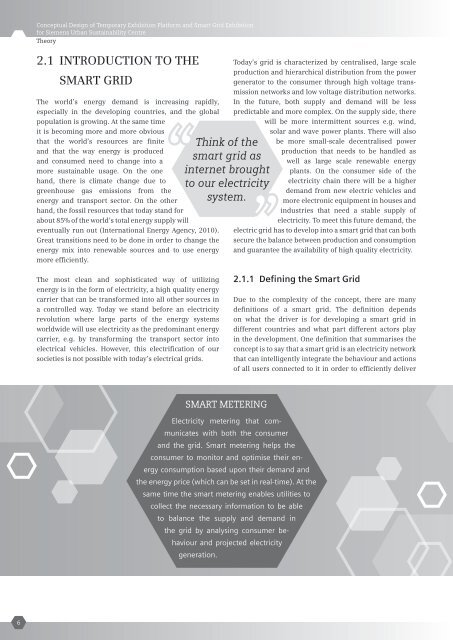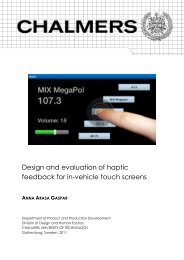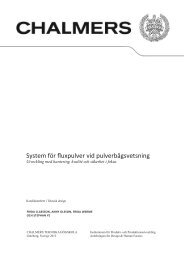Thesis - Teknisk Design
Thesis - Teknisk Design
Thesis - Teknisk Design
- No tags were found...
You also want an ePaper? Increase the reach of your titles
YUMPU automatically turns print PDFs into web optimized ePapers that Google loves.
Conceptual <strong>Design</strong> of Temporary Exhibition Platform and Smart Grid Exhibitionfor Siemens Urban Sustainability CentreTheory2.1 Introduction to theSmart GridThe world’s energy demand is increasing rapidly,especially in the developing countries, and the globalpopulation is growing. At the same timeit is becoming more and more obviousthat the world’s resources are finiteand that the way energy is producedand consumed need to change into amore sustainable usage. On the onehand, there is climate change due to“Think of thesmart grid asinternet broughtto our electricitysystem.greenhouse gas emissions from theenergy and transport sector. On the otherhand, the fossil resources that today stand forabout 85% of the world’s total energy supply willeventually run out (International Energy Agency, 2010).Great transitions need to be done in order to change theenergy mix into renewable sources and to use energymore efficiently.Today’s grid is characterized by centralised, large scaleproduction and hierarchical distribution from the powergenerator to the consumer through high voltage transmissionnetworks and low voltage distribution networks.In the future, both supply and demand will be lesspredictable and more complex. On the supply side, therewill be more intermittent sources e.g. wind,solar and wave power plants. There will alsobe more small-scale decentralised powerproduction that needs to be handled aswell as large scale renewable energyplants. On the consumer side of theelectricity chain there will be a higherdemand from new electric vehicles andmore electronic equipment in houses andindustries that need a stable supply ofelectricity. To meet this future demand, theelectric grid has to develop into a smart grid that can bothsecure the balance between production and consumptionand guarantee the availability of high quality electricity.“The most clean and sophisticated way of utilizingenergy is in the form of electricity, a high quality energycarrier that can be transformed into all other sources ina controlled way. Today we stand before an electricityrevolution where large parts of the energy systemsworldwide will use electricity as the predominant energycarrier, e.g. by transforming the transport sector intoelectrical vehicles. However, this electrification of oursocieties is not possible with today’s electrical grids.2.1.1 Defining the Smart GridDue to the complexity of the concept, there are manydefinitions of a smart grid. The definition dependson what the driver is for developing a smart grid indifferent countries and what part different actors playin the development. One definition that summarises theconcept is to say that a smart grid is an electricity networkthat can intelligently integrate the behaviour and actionsof all users connected to it in order to efficiently deliverSmart meteringElectricity metering that communicateswith both the consumerand the grid. Smart metering helps theconsumer to monitor and optimise their energyconsumption based upon their demand andthe energy price (which can be set in real-time). At thesame time the smart metering enables utilities tocollect the necessary information to be ableto balance the supply and demand inthe grid by analysing consumer behaviourand projected electricitygeneration.6
















